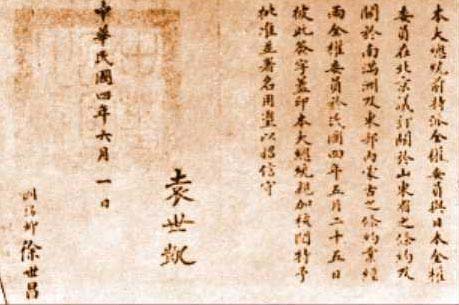 On January 18, 1915, Japan, lead by Prime Minister Ōkuma Shigenobu, presented a secret ultimatum to China consisting of 21 demands which were designed to give Japan regional ascendancy over China. The demands were grouped into five major categories and required, among other demands, that China immediately stop leasing its territory to foreign nations and to ascent to Japanese control over Shandong (one of many Chinese coastal provinces located on the Eastern shore), Manchuria (located on the Northeastern side of the People’s Republic of China, bordering Russia), and Mongolia.
On January 18, 1915, Japan, lead by Prime Minister Ōkuma Shigenobu, presented a secret ultimatum to China consisting of 21 demands which were designed to give Japan regional ascendancy over China. The demands were grouped into five major categories and required, among other demands, that China immediately stop leasing its territory to foreign nations and to ascent to Japanese control over Shandong (one of many Chinese coastal provinces located on the Eastern shore), Manchuria (located on the Northeastern side of the People’s Republic of China, bordering Russia), and Mongolia.
The twenty-one demands were annulled in 1922 at the Washington conference by China’s allies. Japan reluctantly agreed to recognize China as a sovereign state. To some extent, the implications of this seven year old treaty humiliated China and weakened its global position and support among her allies.
Here is a breakdown of some of the specifics outlined in the final draft of the infamous treaty.
Group I: Shantung Control Treaty
Article One
Required the People’s Republic of China to give up the possession of the province of Shantung and to engage in full assent to all crucial matters that Japan and Germany agreed on. This article gave Germany total control of Shantung.
Article Two
This section was meant to restrain China from leasing its land to foreign powers (notably the U.S. and U.K.) especially in or along the Eastern coastline.
Article Three
Japan wanted China to agree to her demands to build a railway line connecting Lungkow or Chefoo with the Kiaochou Tsinanfu railway.
Article Four
This article required the Chinese government to open certain cities and towns in the expansive Eastern shore for commercial and residential usage of foreigners. By giving in to this demand, China had to open all places decided upon in a separate treaty.
Group II: Eastern Mongolia and South Manchuria Treaty
Article One
This portion of the twenty-one demands required China to agree to extend the lease term of South Manchuria Railway, Antung Mukden Railway, and Port Arthur by ninety-nine years.
Article Two
The Japanese subjects would own and/or lease land for commercial and industrial purposes and to erect buildings.
Article Three
Permitted Japan countrymen to enter and reside in Eastern Mongolia and South Manchuria and to carry on any commercial or industrial business at will.
Article Four
This section of the agreement required China to commit to allowing Japan to invade its mines in Manchuria and Mongolia.
Article Five
By subscribing to the twenty-one demands treaty, China was bound to seek Japans consent whenever any major railway construction exercises and loans to the regions of Manchuria and Mongolia were to be affected.
Article Six
The Chinese government was reduced to a minor party as far as the control of Mongolia and Manchuria was concerned as it had to consult Japan whenever any major military, political or financial project pertaining these two regions were being rolled out.
Article Seven
The Chinese government was bound to extend the lease agreement of the Kirin-Chungchun railway line for an extra 99 years.
Group III: Han Yeh Ping Company Treaty
Article One
The Japanese government wanted to enjoy an equal share and equal control over Han Yeh Company. It required the Chinese to involve them on every crucial transaction concerning this firm.
Article Two
The Chinese government was required to not allow any mines in the neighborhood of those owned by Han Yeh Ping, either directly or indirectly, without seeking the company’s consent.
Group IV
This sole-chaptered group required the Chinese not to cede to any foreign power any island or harbor along her Coast.
Group V: Political, Financial and Military Treaty
Article One
China to include influential Japanese in important political, military, and financial decisions.
Article Two
China to allow Japan to construct her hospitals, schools, and temples inside China’s mainland.
Article Three
Japanese citizens to be employed in the Chinese police force.
Article Four
China to outsource some of its armory from Japan.
Article Five
China to allow Japan to construct a railway line from Wuchang to Kiukiang Nachang and from Nachang to Chaochou.
Article Six
Japan to be consulted whenever any foreign works planned for Fuken and Formosa (Chinese province) were underway.
Article Seven
Japanese preachers to preach in China without restrictions.
Summary
This is just a sneak peek to the larger document which is available in local museums and galleries.